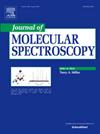WS在13100 cm−1附近的两个转变的旋转分析,以及[15.30]1 - X 3Σ−0+转变的进一步解摄动分析
IF 1.3
4区 物理与天体物理
Q4 PHYSICS, ATOMIC, MOLECULAR & CHEMICAL
引用次数: 0
摘要
利用用于探测的傅立叶变换光谱仪(ILS-FTS),以高分辨率记录了硫化钨(WS)在13100 cm−1附近的两个跃迁,即[13.10]1 - X 3Σ−0+跃迁的(0,0)波段和[15.30]1 - X 3Σ−1跃迁的(0,0)波段。在脉冲直流等离子体发生器中施加0.70-0.80 A的放电电流到钨衬里铜空心阴极形成等离子体放电,产生WS分子。反应发生在Ar(~ 70%)、H2(~ 30%)和CS2(~ 0.1%)气体存在下,总压力约为2torr。测定了182W32S、183W32S、184W32S和186W32S四种富集同位素谱,并用PGOPHER进行了旋转分析。使用约束参数方法来维持同位素间的期望质量关系。该分析将两个激发态的观测旋转能级从J ~ 30增加到J ~ 100,从而提高了光谱常数的精度。对[15.30]1 - X 3Σ−(1)跃迁的新分析使先前确定的X 3Σ−基态0+和1 Ω-components分裂值的不确定性降低。这项工作还提出了对我们先前涉及[15.30]1状态的解摄动分析的扩展,以包括v ' = 2振动能级,它被[14.26]0+状态的v ' = 4振动能级摄动。本文章由计算机程序翻译,如有差异,请以英文原文为准。
![Rotational analyses of two transitions of WS near 13,100 cm−1, and further deperturbation analysis of the [15.30]1 – X 3Σ−0+ transition](https://img.booksci.cn/booksciimg/2025-2/100299130841769516361.jpg)
Rotational analyses of two transitions of WS near 13,100 cm−1, and further deperturbation analysis of the [15.30]1 – X 3Σ−0+ transition
Two transitions of tungsten sulfide (WS) near 13,100 cm−1, the (0,0) band of the [13.10]1 – X 3Σ−0+ transition and the (0,0) band of the [15.30]1 – X 3Σ−1 transition, have been recorded at high resolution using intracavity laser absorption spectroscopy with a Fourier-transform spectrometer used for detection (ILS-FTS). The WS molecules were produced in the plasma discharge formed by applying 0.70–0.80 A of a discharge current from a pulsed DC plasma generator to a tungsten-lined copper hollow cathode. The reaction took place in the presence of Ar (∼70 %), H2 (∼30 %), and CS2 (∼0.1 %) gases at a total pressure of approximately 2 torr. Lines for all four abundant isotopologues of WS, 182W32S, 183W32S, 184W32S, and 186W32S, were measured and a rotational analysis was performed using PGOPHER. A constrained parameters approach was used to maintain expected mass relationships among isotopologues. This analysis increases the number of observed rotational levels from J ∼ 30 to J ∼ 100 for both excited states, allowing an increase in precision of spectroscopic constants. The new analysis of the [15.30]1 – X 3Σ−(1) transition enabled the reduced uncertainty in the previously determined value for the splitting of the 0+ and 1 Ω-components of the X 3Σ− ground state. Also presented in this work is an expansion upon our earlier deperturbation analysis involving the [15.30]1 state to include the v′ = 2 vibrational level, which is perturbed by the v′ = 4 vibrational level of the [14.26]0+ state.
求助全文
通过发布文献求助,成功后即可免费获取论文全文。
去求助
来源期刊
CiteScore
2.70
自引率
21.40%
发文量
94
审稿时长
29 days
期刊介绍:
The Journal of Molecular Spectroscopy presents experimental and theoretical articles on all subjects relevant to molecular spectroscopy and its modern applications. An international medium for the publication of some of the most significant research in the field, the Journal of Molecular Spectroscopy is an invaluable resource for astrophysicists, chemists, physicists, engineers, and others involved in molecular spectroscopy research and practice.

 求助内容:
求助内容: 应助结果提醒方式:
应助结果提醒方式:


